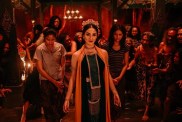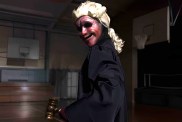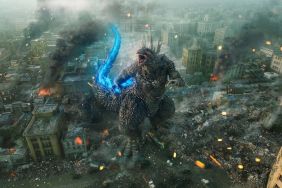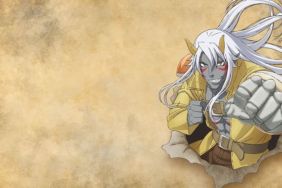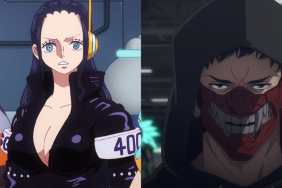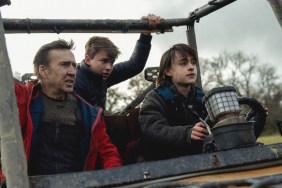
Director Edwards – who previously helmed the 2010 DIY creature flick Monsters – applies the same aesthetic that made his feature debut feel refreshing to Godzilla. That is to say this movie isn’t a start-to-finish, sustained action sequence that’s out to desensitize us by the time we reach the big finale. Instead, Godzilla serves to re-introduce the sense of awe and wonder that has been lost in movies of this ilk, meaning…you’re going to have to spend some down time with the characters before Godzilla comes up for air to do his thing. When those “G-moments” come, they’re terrific rewards.
I just wish the character drama was as strong as the emotional weight I felt for Godzilla himself (hey, the movie is named after him, so I guess he deserves that). Adopting Spielberg and Irwin Allen-like narrative threads, Godzilla is primarily a chase film with the U.S. Army and a secret agency called Monarch (which has known about Godzilla for decades) on the trail of two MUTOs (Mutated Unidentified Terrestrial Organisms), ancient parasites that have hatched and are responsible for the destruction of a Japanese nuclear facility in the ’90s and Las Vegas, respectively. Their arrival has brought Godzilla – an “alpha predator”/prehistoric creature that thrives on radiation deep within the Earth – out of hibernation (classic Atomic Age film conceit). Caught up in this monstrous three-way is the Brody family – Bryan Cranston’s Joe, Aaron Taylor-Johnson’s Ford and his wife Elle (Elisabeth Olsen). Joe and Ford harbor painful memories; they experienced the nuclear disaster first-hand and their knowledge will aid the military and Monarch’s Dr. Serizawa (Ken Watanabe).
Godzilla places much of its dramatic weight on the family dynamic of Ford and Elle. Aaron Taylor-Johnson simply delivers wooden performance and Elle isn’t given much to do at all but simply be at the right place at the right time to witness the disastrous events that occur when all three of the film’s monsters intersect. Cranston, as usual, gives the film some much-needed color and gravity. Also on the clunky side of things is Ford’s actual journey. The film propels him to Japan at the start of story and he has to find his way back home to San Francisco. The decisions he makes and the plot turns that alter his direct line back his family are a bit muddled. Further, Serizawa strangely disappears for a good portion of the film. His character – while important – is slightly mishandled. The ensemble cast are afflicted with pretty much the same problems many disaster movies have in which there is a fight for screen time or too little care is given to those who matter most in the story. Godzilla has the pieces in place for a strong “human drama” backbone, it’s just not fully realized.
As you would expect, when the monsters are on screen, that’s where the film excels. The MUTOs – multi-limbed creatures who have eyes that look like the headlights of a rad sports car – are a worthy addition to the kaiju canon. There are no subtleties to their existence. They’re here to remind us nukes are bad, after all, that’s what they feed on (Godzilla enters the picture as the one who has to clean this mess up) – which is a nice touch. They don’t suffer the bane of being overdesigned like so many creatures are today, yet their texture feels incomplete. And the way they move is eerie. More than once, Edwards smartly uses their body language and presence to strike a gleeful sense of terror – the best moment coming when the passengers of an airport shuttle realize their transport is heading directly towards a MUTO looming over their track (next stop, a giant gaping mouth!).
Godzilla, on the other hand, is a brute who utilizes everything he’s got – weight, height, occasional reach (I love his arms), tail and a few other surprises – to take on his enemy. There’s no hesitation to his attack, he just dives right in, grappling with his opponent. And what he represents has adjusted slightly since the 1954 film. Here, he’s more in line with some of the themes of the later films, sans the goofiness. He’s the “earthquake” or “tornado” or “violent storm” of a sprawling disaster film, unaware of the impact his presence has on us when he stomps around our cities. He’s Mother Nature’s champion. One more surprise our planet has to throw at humanity. He’s not evil. He’s merely going off animal instinct. And, as an audience, we love him for this. By simply being a beautifully-designed, well-realized creature we’re on his side. When he suffers, we feel bad. When he triumphs, we’re on our feet applauding. Edwards and his awesome visual FX team give Godzilla character without hitting the audience over the head with it.
And I should say that Edwards has a lot of fun depicting the monsters in action. It fiercely goes against the perspective of what you would expect and it works quite well. The first monster battle might infuriate some, but it’s pretty damn clever, falls in line with that Monsters-like freshness I brought up earlier and left me smiling and wanting more. And again, there are some terrific rewards for being patient. That being said, Edwards still can’t help himself to interupt his own visual give us some glorious wide cityscape shots with
I’ve seen Godzilla twice now and the film is even stronger on a second viewing once my expectations were set aside (I’m a big Godzilla fan) and I could digest the film a bit more. Edwards proved to be the right choice for this. His instincts were spot-on, even if the script needed perhaps one more pass, and I think this movie is going to propel him into some pretty big projects. As for Godzilla, I think they’ve finally got a reboot that works and I’m so ready to see what they do with him next.
